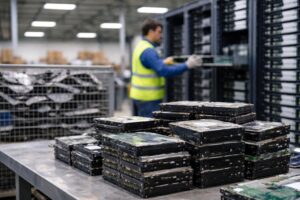Corrosion in industrial pipe networks doesn’t begin when a pipe leaks—it starts earlier, in the unseen space where water meets metal. That contact zone, the metal-water interface, is where chemistry and flow combine to initiate deterioration long before it’s noticed on a screen or during an inspection.
Industrial operators manage flow rates, monitor additives, and control temperature, but few track what happens at this internal boundary in real time. And fewer still account for how those reactions vary by industry. From ultrapure loops in pharma to high-salinity exposure in coastal facilities, corrosion in industrial pipe networks expresses itself in different ways.
This article moves beyond generalities. It shows how corrosion initiates at the interface, how risks evolve across industries, what failure modes engineers often miss, and which tools now offer early, system-specific visibility—before any damage surfaces.
What Actually Happens at the Metal-Water Interface
Before Corrosion in industrial pipe networks ever causes structural failure, chemical and mechanical interactions begin deep inside the pipe wall, at molecular interfaces shaped by temperature, flow turbulence, and ion concentrations. This section reveals what drives these early failures:
Role of Dissolved Oxygen in Oxidation Initiation
Even trace oxygen—from startup air, poor sealing, or dosing slipups—makes water reactive. Moreover, it sparks oxidation deep within pipe walls, especially in high-velocity zones that appear intact during routine checks. That’s corrosion in industrial pipe networks at its quietest—and most dangerous—stage.
Without real-time corrosion monitoring tools, this damage spreads before teams can respond. Open-loop systems or variable dosing make conditions even riskier. In many cases, oxidation starts within hours of commissioning. Visual inspections miss it; chemistry doesn’t. That’s why early detection now defines whether systems hold or quietly fail.
Electrochemical Reactions Between Water and Pipe Alloys
Different alloys behave differently under flow. That’s a design fact. But even uniform metals form electrochemical cells internally, especially at weld seams, cold-worked sections, or stress-exposed zones. These cells form microcurrents. The anodic regions dissolve.
Now add two metals: a carbon steel bolted to stainless steel, or a copper contact inside steel. That’s a full galvanic circuit. Water carries a charge, and corrosion localizes at the anodic junction. What’s tricky is that this effect doesn’t show up in total pipe loss—it’s narrow, deep, and often wrongly blamed on handling or wear. Unless water chemistry is matched to material spec, the metal-water interface becomes the site of unmonitored degradation.
Chloride Ions as Accelerators in Coastal and Treated Water
Chlorides don’t need high concentrations to damage stainless steel. They penetrate oxide layers, destabilize grain structure, and trigger pitting quietly and precisely. It starts in recirculation zones, where flow is slow and turbulence drops. That’s where chloride ions concentrate.
Coastal plants face it with raw intake. Softened loops get it from salt dosing. Even treated water introduces trace amounts during cleaning or brine recovery. These ions don’t flush easily. Additionally, they settle, interact, and trigger deep corrosion in industrial pipe networks—often advancing unnoticed until the risk turns operational. That’s why chloride-driven corrosion often escapes attention.
Impact of Water pH and Alkalinity on Corrosive Behavior
Water out of spec doesn’t announce itself. A slight drop in pH during a hot rinse. A slow alkalinity shift in a return line. These seem small—until they alter the surface chemistry of the pipe. Suddenly, passive layers dissolve or deposits begin forming where none should.
Low pH attacks directly. High pH deposits hide under-deposit corrosion. Alkalinity makes both harder to reverse. Because buffer capacity slows correction, a single event can create days of corrosive exposure. And with no inline monitoring, that chemistry moves unchecked through multiple systems. The metal-water interface, if left untracked across temperature shifts and dosing changes, becomes the primary site of gradual, invisible loss.
Industry-Specific Corrosion Challenges and Risk Profiles
Corrosion in industrial pipe networks doesn’t look the same in every sector. This section identifies how water chemistry, temperature, and system function shape unique industry-specific corrosion challenges:
Pharmaceutical Systems: Purity-Induced Vulnerabilities
Purity isn’t optional in pharmaceutical water—it’s engineered into every drop. But in chasing zero contaminants, these systems also remove the natural buffering agents that help stabilize water chemistry. What you gain in cleanliness, you risk in chemical fragility. Without those stabilizers, water becomes more reactive. It seeks balance by pulling electrons from metal surfaces, even stainless steel.
With frequent cleaning and hot sanitization cycles, thermal and chemical swings intensify corrosion potential. Pinholes often appear in orbital welds or at passivation gaps. Because these networks operate under strict validation, even minor corrosion can compromise product safety. So, that makes internal degradation a critical risk, despite the system’s outward sterility.
Food & Beverage Pipelines: Cleaning and Thermal Cycling Stress
In food and beverage systems, corrosion isn’t driven by contamination—it’s triggered by maintenance. CIP cycles introduce alkaline cleaners, acidic rinses, and heat, all in quick succession. These shifts destabilize oxide layers and expose fresh metal repeatedly.
Low-flow branches and drain lines experience stagnant rinse water, which often turns aggressive with time. Over weeks, under-deposit corrosion develops beneath biofilms or leftover residues. The result: highly localized failures that go undetected until system pressure drops or hygiene audits fail.
Oil & Gas Networks: Sulfide and CO2-Driven Internal Attack
When carbon dioxide enters the water stream, it reacts to form carbonic acid, a common and corrosive presence in oilfield systems. Hydrogen sulfide forms weak sulfuric derivatives. Both are common in oilfield water systems, and both accelerate metal loss from inside the pipe. Carbon steel, in particular, degrades rapidly in these conditions.
Corrosion products form iron carbonate or sulfide films, but these layers are brittle. They flake under stress or dislodge during flow surges, exposing fresh metal. Furthermore, that makes protective buildup unreliable. Without continuous monitoring, pitting becomes widespread in flowlines, separators, and gathering systems.
Data Center Cooling Loops: Microbial Growth and Stagnant Zones
Chilled water systems in data centers operate under tight thermal tolerances. These low-temperature loops frequently develop stagnant pockets in secondary lines or during load shifts. In these quiet zones, sulfate-reducing bacteria often thrive & multiply.
Their metabolic byproducts break down passive films. Over time, microbiologically influenced corrosion leads to sharp pipe wall thinning, especially around weld seams/ dead ends. Chemical dosing helps, but without flow consistency, risk returns quickly. These zones become silent corrosion incubators.
Overlooked Corrosion Modes Hidden in Plain Sight
Not all corrosion looks like rust. This section reveals high-impact failure types that often go misdiagnosed or missed entirely:
Crevice Corrosion in Gasketed and Clamped Joints
Wherever a gap exists—between a gasket and flange, or inside a clamp fitting—fluid slows down. These low-flow zones experience oxygen drop-off, setting the stage for crevice corrosion. Because the pH inside the crevice differs from the bulk fluid, metal begins dissolving.
What makes this failure mode dangerous is how invisible it remains. Additionally, external coatings stay intact, and surface readings pass. Yet material loss progresses inward. It’s especially common in stainless systems that rely on mechanical connections and compact routing.
Vapor-Phase Corrosion in Condensate Spaces
Steam systems and hot water loops aren’t safe from corrosion just because they appear dry. Condensation leaves behind thin films of water in traps, vents, or elevation changes. If oxygen is present, this layer becomes a corrosive film.
Because it’s not a full liquid phase, dosing systems can’t neutralize it effectively. That makes these vapor zones prone to oxidation, particularly on startup. Over time, vapor-phase corrosion causes unexpected thinning near high points and vent stacks.
Galvanic Corrosion in Poorly Specified Assemblies
When dissimilar metals connect electrically in the presence of water, galvanic corrosion begins. It doesn’t require electrical current—just a conductive fluid and two metals with different potentials. The less noble one becomes the anode and starts to dissolve.
Installers often overlook this at transition fittings or temporary repairs. Even stainless-to-brass or aluminum-to-steel joins can trigger aggressive local attack. Moreover, once started, the current reinforces itself. Damage concentrates at the interface, regardless of surface treatment or external protection.
Under-Deposit Corrosion from Scaling and Fouling
Any material that settles—scale, biofilm, dirt—creates a localized environment underneath. Oxygen drops, pH shifts, and ions concentrate. This layer hides corrosion in progress. It can remain stable for months, then accelerate suddenly.
Routine cleaning often leaves behind residues, especially in areas with poor access. As these layers build, under-deposit corrosion forms pits or stress points that remain hidden until failure occurs. It remains one of the hardest forms to monitor without physical inspection.
Detection and Prevention: What’s Now Possible
Corrosion no longer needs to be invisible. This section explores modern tools now available to detect, predict, and prevent pipe degradation at its earliest stage:
Fiber Optic Sensors for Real-Time Wall Loss Monitoring
Fiber optics can detect microstrain and temperature shifts down to the centimeter. When bonded to pipe walls, they register deformation as corrosion erodes the metal. These signals update real-time corrosion monitoring tools, even across buried or insulated networks.
Unlike spot readings, fiber systems show where and how fast corrosion spreads. They enable preemptive shutdowns before damage escalates. Additionally, as deployment costs drop, fiber optics are becoming viable not just in critical pipelines, but across corrosion in industrial pipe networks more broadly.
Digital Twins Paired with Water Chemistry Analytics
Digital twins map physical infrastructure into a dynamic software model. When paired with water chemistry inputs—pH, flow, conductivity, temperature—they simulate where corrosion is most likely to occur next.
These systems can integrate with SCADA or BMS platforms, updating continuously as conditions change. Instead of reacting to corrosion, teams now model it, adjusting treatment, flow balance, or materials based on predictive risk. For large facilities, digital twins are shifting corrosion in industrial pipe networks from guesswork to strategy. Failures no longer have to surprise teams—because with real-time modeling and chemistry-aware diagnostics, corrosion becomes predictable, not reactive.
Advanced Coatings and Nanofilms for Internal Protection
Traditional coatings could resist, but only to a point. Today’s materials blend ceramic strength with polymer flexibility, letting them adjust to shifting flow, chemical volatility, and sudden pressure, without breaking down. As a result, they actively reshape how teams manage corrosion in industrial pipe networks.
More importantly, these coatings now align with real-time tools. Paired with wall-loss sensors or digital models, they help stop damage before it starts. In systems carrying high-TDS brines or ultrapure water, the early protection matters. Furthermore, by preventing corrosive contact at the surface, these films shift protection from reactive to predictive, bringing reliability forward into the design phase.
Integrated Corrosion Management Platforms
Single-point solutions are fading. Today’s best practice includes integrated platforms that unify sensor data, chemical dosing, inspection reports, and failure analytics into a single dashboard.
These systems let teams track corrosion in industrial pipe networks over time, correlate it with process events, and intervene early. For multi-site operations or utility providers, platform-level insight replaces scattered spreadsheets and delayed testing. The result: faster decisions, fewer surprises, and measurable gains in system life.
To Sum Up
Corrosion in industrial pipe networks doesn’t begin with damage—it begins with neglect. Most failures start at the metal-water interface, long before they show up as pressure loss or visible rust. But with sector-specific insight and modern tools, operators no longer have to wait for signs of decay. Corrosion control is no longer a side task—it’s part of how modern systems stay competitive, safe, and future-ready.
The 2nd Industrial Water & Wastewater Management Summit 2025 in Barcelona, Spain, on October 7–8 delivers cross-sector knowledge, applied strategies, and access to technologies that move teams from reaction to prevention. If you’re shaping infrastructure decisions, this is where insight meets execution. Register now.




